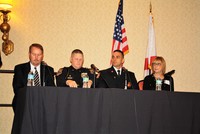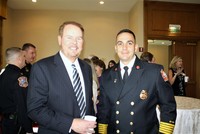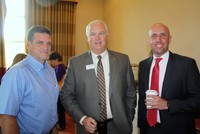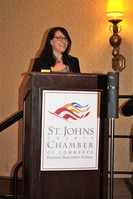




With Hurricane Matthew a not-so-distant memory, local government and public safety officials say that now is the time for local businesses to learn from last year’s major storm and prepare for this year’s hurricane season.
Learning the lessons of Hurricane Matthew was the focus of the St. Johns County Chamber of Commerce’s quarterly Economic Development Council breakfast. Held May 25 at the World Golf Village Renaissance Resort, the event featured a panel discussion during which participants urged business leaders to takes steps now to prepare for potential future storms. Panelists included St. Johns County Administrator Michael Wanchick, St. Augustine Beach Police Chief Robert Hardwick, St. Augustine Fire Chief Carlos Aviles and Marge Cirillo of the Florida Small Business Development Center.
“I challenge you to prepare yourself and your business,” Hardwick told attendees. “Prepare your business for an evacuation. Because there will be another storm. It’ll happen again.”
Recovering from Matthew
“It’s important to note that Hurricane Matthew was a Category 3 hurricane, and it inflicted more damage on St. Johns County than anywhere else in the state of Florida,” County Administrator Wanchick said, noting that 150,000 people – more than half the county’s population – were affected by the mandatory evacuation order, with thousands seeking refuge in nine county-run shelters for up to three weeks.
“It was a real challenge to maintain,” he said. “The cost to the county is $180 million. That doesn’t include individual impacts to homes and businesses.”
Yet despite the devastation experienced to the county’s coastal areas, panelists uniformly credited the level of cooperation among government agencies, public safety personnel, residents and businesses for enabling St. Johns County to recover from the storm relatively quickly. Wanchick, who noted that he had been through similar disaster situations in South Florida, called the cooperation seen locally during Hurricane Matthew “unprecedented.”
“There were very high levels of cooperation and coordination,” he said. “Everyone had a role and they fulfilled it perfectly. It was a flawless effort across the board.”
Police Chief Hardwick agreed, citing the key role that social media played in law enforcement’s ability to communicate in real time with local residents.
“We reached out to our community and they listened,” he said. “We told our hotels, ‘You should leave’ and they did. They locked the doors.”
In the wake of the storm, businesses received assistance form the Small Business Development Center, which worked with business owners to secure financial assistance through the Small Business Emergency Loan Program.
“Those small businesses, they play a large role in the economic development of the county,” Cirillo said. “Those loans really assisted small business owners with the road to recovery and helping them to open their doors again, pay their employees and get some of those small repairs done.”
Fire Chief Aviles, meanwhile, stressed that the responsibility for preparing for and recovering from disasters rests at the local level.
“FEMA has its role – but FEMA’s not going to come in and wave a magic wand and put the community back the way it was,” Aviles said. “That’s on us.”
Panelists urged attendees to develop and implement disaster recovery plans to ensure their businesses will be prepared for the next storm or business interruption.
“We do hurricane exercises as a government,” Hardwick said, “and businesses should do hurricane exercises, too.”
Aviles agreed. “The goal of recovery shouldn’t be to get back to normal,” he said. “It should be to get back to better than normal – to make this community more resilient than it was before the storm.”